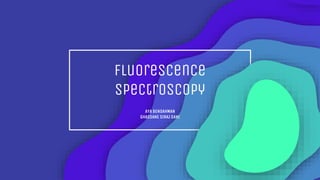
Fluorescence
- 2. Summary: 1. What is the phenomenon of Fluorescence? 2. How does fluorescence spectrometry work ? 3. What are it’s pros and cons? 4. Some of its implication and utilities.
- 4. Fluorescence The emission of electromagnetic waves, (luminescence) caused by the excitation of atoms or nanostructure, which they re-emit immediately (with-in 10^-8 s).
- 5. Phosphorescence Another type of luminescence that is caused by the absorption of radiations, and that continues for noticeable amounts of time. Even after the radiation source stops.
- 6. The commun point between fluorescence and phosphorescence is the release of photons while the electrons return to the ground state. However they differ in the duration in which they do it.
- 7. The actual difference between them: Fluorescence When the atom relaxes to the ground state (and emits photons) without any change in electron spins. Phosphorescence there is a change in electron spin, which results in a longer lifetime of the excited state (second to minutes).
- 8. 8 Absorption Of the radiation’s energy E = h*f. Excitation State Where the electron’s energy levels change. Re-emission Where lies the difference between the two phenomenons. Re-cap
- 10. Fluo/phosphorescence spectroscopy ➢ Photoluminescence spectroscopy is a contactless, nondestructive method of probing the electronic structure of materials. It consists of the study of UV, visible, and near- infrared (NIR) light that is emitted by a chemical species after having absorbed light.
- 12. Luminescence spectroscopy procedures DAY 1 Preparation of Samples DAY 2 Exposure & Re-emission
- 14. Background effects due to light scattering Solvent effects Interfering nonspecific fluorescence Concentration effects Inner filter effects, concentration quenching Sample effects Light scattering, interfering fluorescence, sample adsorption Here you could talk about this person Limitations of fluorescence Measurements
- 15. Avdantages of fluorescence spectroscopy SENSITIVITY: •It is more sensitive as concentration is low as ug/ml or ng/ml. PRECISION: • Upto 1 % can be achieved. SPECIFICITY: • More specific than absorption method where absorption maxima may be same for two compounds. RANGE OF APPLICATION: Even non fluorescent compounds can also be converted to fluorescent compounds by chemical compounds.
- 16. DisAvdantages of fluorescence spectroscopy Not really useful for identification Not all compounds fluorescence Contamination can quench the fluorescence and hence give false/no results
- 17. Applications of luminescence spectroscopy Analytical Chemistry Environmental studies Biochemistry 01 02 03 04 Pharmacy 05 Medecine
- 18. Thank you for your attention
Notes de l'éditeur
- 10 to the minus 8 power
- phosphorescence exhibits a longer lifetime (~10 to -4 power – 10 to -2 power seconds) compared with fluorescence (~10^-9 – 10^-6 seconds)
- The Pauli exclusion principle requires that no two electrons in an atom have the same identical set of quantum numbers; hence when two electrons reside in a single
- While absorption occurs on the timescale of less than 10-15 seconds, the relaxation process from the excited to the ground state is much slower. Therefore, fluorescence can provide information on a fluorophores’ interactions with surrounding molecules and solvents, unlike absorption. Fluorescence intensity is directly proportional to the excitation light intensity F=2.303 * K * I0 * εbc The fraction of a parallel beam of light absorbed by a sample is independent of the intensity of the incident beam and is related to the concentration of the absorbing species by the familiar Beer-Lambert Law: I = intensity of transmitted light Io = intensity of incident light E = molecular extinction coefficient c = concentration in gm moles/L-1 l = pathlength of sample
- Solid materials do not really need any preparations except for cutting Powdered materials need to be grinded and pressed. Liquids are prepared by pouring them into a plastic cup —------- We expose the sample to the radiation source through the excitation monochromator then the emitted radiation is treated through the emission monochromator in order to obtain both spectrums. —-------------- Excitation spectra plot the intensity at a fixed emission wavelength while varying the excitation wavelengths. Since most emission spectra are independent of the excitation wavelength, the excitation spectra are frequently duplicates of the fluorophore’s absorption spectrum.
- While absorption occurs on the timescale of less than 10-15 seconds, the relaxation process from the excited to the ground state is much slower. Therefore, fluorescence can provide information on a fluorophores’ interactions with surrounding molecules and solvents, unlike absorption. Fluorescence intensity is directly proportional to the excitation light intensity F=2.303 * K * I0 * εbc The fraction of a parallel beam of light absorbed by a sample is independent of the intensity of the incident beam and is related to the concentration of the absorbing species by the familiar Beer-Lambert Law: I = intensity of transmitted light Io = intensity of incident light E = molecular extinction coefficient c = concentration in gm moles/L-1 l = pathlength of sample
- While absorption occurs on the timescale of less than 10-15 seconds, the relaxation process from the excited to the ground state is much slower. Therefore, fluorescence can provide information on a fluorophores’ interactions with surrounding molecules and solvents, unlike absorption. Fluorescence intensity is directly proportional to the excitation light intensity F=2.303 * K * I0 * εbc The fraction of a parallel beam of light absorbed by a sample is independent of the intensity of the incident beam and is related to the concentration of the absorbing species by the familiar Beer-Lambert Law: I = intensity of transmitted light Io = intensity of incident light E = molecular extinction coefficient c = concentration in gm moles/L-1 l = pathlength of sample
- -Detecting compounds from HPLC flow - Plant pigments, steroids and proteins can be determined at low concentrations. —--- Detecting and quantifying polluants such as polycyclic aromatic hydrocarbons —--- Used generally as a non-destructive method of traking biofluorescent compounds —--- Direct and indirect analysis for multiple drugs -vitamins -catecholamins(dopamin) - Measuring the impurities of a sample —--- Ability to identify different levels skin tumors. lIdentifying blood stains using fluoresdcent reagents.